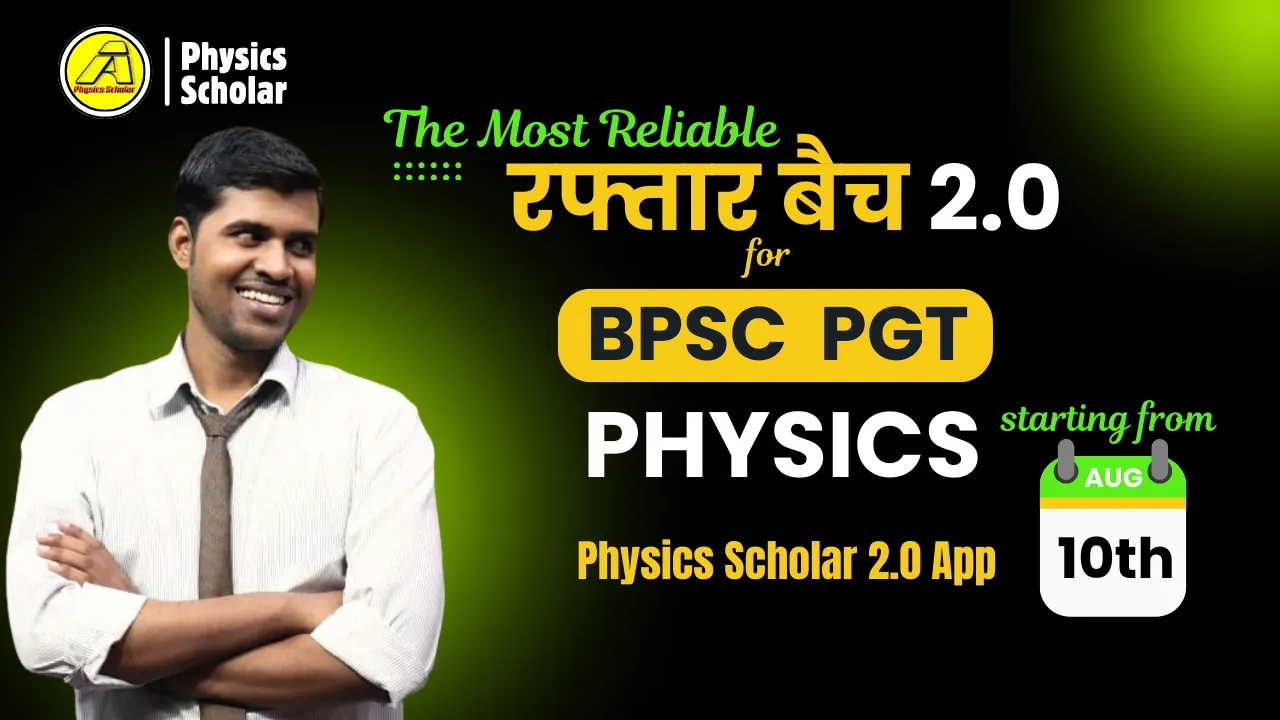How to Become a Physics Lecturer in Bihar: BPSC PGT Physics Complete Guide [Eligibility, Exam Pattern, Syllabus, PYQs]
![Physics Lecturer in Bihar: BPSC PGT Physics Complete Guide [Eligibility, Exam Pattern, Syllabus, PYQs]](https://physicsscholar.com/wp-content/uploads/2025/06/BPSC-PGT-Physics-Guide.webp)
Dreaming of becoming a Physics Lecturer in Bihar’s government schools? The BPSC PGT Physics (Post Graduate Teacher) exam, conducted by the Bihar Public Service Commission (BPSC), is your ticket to this prestigious role. Whether you’re a fresh postgraduate or an experienced professional, this detailed guide by Physics Scholar will walk you through everything you need to ace the BPSC PGT Physics exam.
From eligibility criteria (including the mandatory STET Paper 2 qualification) to the exam pattern, syllabus, selection process, and the power of Previous Year Questions (PYQs), we’ve got it all covered in simple, relatable language to help you rank high on Google and succeed in your prep!
Who is a BPSC PGT Physics Lecturer?
A BPSC PGT Physics Lecturer teaches Physics to students in classes 11 and 12 in Bihar’s government higher secondary schools. It’s a fulfilling career with job security, a competitive salary (as per the 7th Pay Commission), and the chance to inspire young minds.
The path to this role involves clearing the BPSC Teacher Recruitment Exam (TRE) for Higher Secondary Teachers (PGT) in Physics. Let’s break down the steps to make this dream a reality.
Eligibility Criteria for BPSC PGT Physics
To apply for the BPSC PGT Physics exam, you must meet the following eligibility criteria:
- Educational Qualification:
- A Master’s degree in Physics (M.Sc. Physics) from a recognized university with at least 50% marks.
- A B.Ed. degree or equivalent qualification is mandatory for teaching positions.
- Alternatively, candidates with a Ph.D. in Physics or a 2-year Diploma in Elementary Education may be eligible, depending on the specific BPSC notification.
- Mandatory STET Qualification: Candidates must have qualified the Bihar State Teacher Eligibility Test (STET) Paper 2 for Higher Secondary Teachers in Physics. This is a crucial requirement to be eligible for the BPSC PGT Physics post.
- Age Limit:
- Minimum age: 21 years.
- Maximum age: 37 years for unreserved (general) male candidates and 40 years for unreserved female candidates and reserved categories (BC/MBC).
- Age relaxation:
- 3 years for Female (General), BC, and MBC candidates.
- 5 years for SC/ST candidates.
- Note: Candidates already employed in Bihar government services may have no upper age limit, as per certain notifications.
- Nationality:
- Must be a citizen of India, preferably a domiciled resident of Bihar.
- Additional Requirements:
- Proficiency in English and one of Hindi/Urdu/Bangla, tested in the Language section of the exam.
- Candidates must meet the Bihar Teacher Eligibility Criteria outlined in the official BPSC notification.
Important: Always verify the latest BPSC TRE notification on the official website (bpsc.bih.nic.in) for any updates, especially regarding the STET Paper 2 requirement or other eligibility changes.
BPSC PGT Physics Exam Pattern
The BPSC PGT Physics exam (part of the BPSC TRE for Higher Secondary Teachers) tests your language skills, general knowledge, and Physics expertise through a single written exam consisting of 150 multiple-choice questions (MCQs) worth 150 marks. Here’s the breakdown:
- Total Questions: 150 MCQs
- Total Marks: 150
- Duration: 2 hours 30 minutes
- Negative Marking: No negative marking, so attempt all questions!
The question paper is divided into three parts:
- Part I: Language Section (30 marks)
- Tests proficiency in English and one of Hindi/Urdu/Bangla.
- Candidates must score at least 30% (9 marks) to qualify this section.
- Questions focus on grammar, vocabulary, and comprehension.
- Part II: General Studies (40 marks)
- Covers:
- Elementary Mathematics: Arithmetic, algebra, percentages, time and work.
- General Awareness: Current affairs, national/international events.
- General Science: Basic concepts of Physics, Chemistry, and Biology.
- Indian National Movement: Freedom struggle, Bihar’s contributions (e.g., Champaran Satyagraha).
- Geography: Physical, social, and economic geography of India and Bihar.
- Questions align with the SCERT syllabus and don’t require deep specialization.
- Part III: Subject-Specific (Physics) (80 marks)
- Focuses on Physics at the postgraduate level (equivalent to a 3-year Honours course at Patna University).
- Tests core concepts, numerical problem-solving, and teaching aptitude in Physics.
Key Notes:
- The Language section is qualifying in nature; you must score 30% to proceed.
- The final merit list is based on Parts II and III (120 marks).
- The exam is conducted in Hindi and English.
BPSC PGT Physics Selection Process
The selection process for BPSC PGT Physics is streamlined and includes:
- Written Examination:
- Candidates must clear the 150-mark MCQ-based exam described above.
- Those who meet the cutoff marks qualify for the next stage.
- Document Verification:
- Shortlisted candidates undergo document verification to confirm eligibility (e.g., M.Sc. degree, B.Ed., STET Paper 2 certificate, caste certificates, etc.).
- A medical examination may be required to ensure fitness for teaching.
Note: The BPSC TRE 4.0 (2025 cycle) does not include an interview, making the written exam the primary selection criterion.
BPSC PGT Physics Syllabus
The BPSC PGT Physics syllabus covers General Studies (Part II) and Physics (Part III). Here’s a detailed look:
Part II: General Studies Syllabus
- Elementary Mathematics: Number systems, percentages, profit and loss, ratio and proportion, time and distance.
- General Awareness: Current events, awards, sports, important days, and national/international news.
- General Science: Basic concepts of Physics, Chemistry, and Biology (non-specialized).
- Indian National Movement: 19th-century resurgence, freedom struggle, Bihar’s role (e.g., Quit India Movement).
- Geography: Physical geography, economic and social geography of India and Bihar, major river systems.
Part III: Physics Syllabus
The Physics syllabus is aligned with a Master’s level curriculum and includes:
- Mechanics: Newton’s laws, gravitation, rotational dynamics, fluid mechanics.
- Thermodynamics: Laws of thermodynamics, heat transfer, kinetic theory of gases.
- Electromagnetism: Electrostatics, magnetic fields, electromagnetic induction, Maxwell’s equations.
- Optics: Reflection, refraction, interference, diffraction, polarization.
- Modern Physics: Quantum mechanics, atomic and nuclear physics, relativity.
- Waves and Oscillations: Simple harmonic motion, wave motion, sound waves.
- Electronics: Semiconductors, digital electronics, basic circuits.
- Mathematical Physics: Vector analysis, differential equations, complex analysis.
BPSC PGT Physics Syllabus – Download PDF | Bihar PGT Physics Syllabus ![]()
Pro Tip: The syllabus draws heavily from NCERT textbooks (Class 11-12) and standard postgraduate Physics books. Download the official BPSC TRE syllabus PDF from bpsc.bih.nic.in for the complete list.
Why BPSC PGT Physics Previous Year Questions (PYQs) Are Crucial
Solving BPSC PGT Physics Previous Year Questions (PYQs) is a game-changer for your preparation. Here’s why:
- Spot Key Topics: PYQs highlight frequently tested areas like Mechanics, Electromagnetism, and Modern Physics.
- Understand Exam Trends: Get a feel for the question types and difficulty level.
- Enhance Time Management: Practice under timed conditions to solve questions faster.
- Build Confidence: Familiarity with real exam questions reduces exam-day stress.
At Physics Scholar, we provide free BPSC PGT Physics PYQs PDFs with solutions to streamline your prep. Our PDFs offer:
- Questions from multiple years (e.g., BPSC TRE 1.0, 2.0, 3.0).
- Detailed, easy-to-understand solutions in simple language.
- Topic-wise organization for targeted practice.
How to Access: Visit Physics Scholar, head to the BPSC PGT Physics section, and download the PDFs instantly. [Interlink to your PYQs article or download page for SEO boost.]
Step-by-Step Guide to Prepare for BPSC PGT Physics
Here’s a practical plan to help you become a BPSC PGT Physics Lecturer:
- Check Eligibility and STET Status:
- Ensure you have an M.Sc. in Physics, B.Ed., and a valid STET Paper 2 qualification in Physics.
- Verify other eligibility criteria (age, nationality) per the latest BPSC notification.
- Master the Syllabus and Exam Pattern:
- Download the official syllabus from bpsc.bih.nic.in and focus on high-weightage Physics topics like Mechanics, Electromagnetism, and Modern Physics.
- Build a Strong Foundation:
- Study NCERT Physics textbooks (Class 11-12) for core concepts.
- Refer to standard books like:
- Concepts of Physics by H.C. Verma.
- Fundamentals of Physics by Halliday, Resnick, and Walker.
- Introduction to Electrodynamics by David J. Griffiths.
- Quantum Mechanics by Zettili or Griffiths.
- Practice with PYQs and Mock Tests:
- Download BPSC PGT Physics PYQs PDFs from Physics Scholar to practice real exam questions.
- Take mock tests to simulate exam conditions and improve speed.
- Strengthen General Studies:
- Study NCERT books (Class 6-12) for General Science, History, Geography, and Indian National Movement.
- Follow The Hindu or apps like Physics Wallah for current affairs.
- Polish Language Skills:
- Practice English and Hindi grammar and comprehension using Bihar Board textbooks or similar resources.
- Aim to score above 30% in the Language section.
- Revise Regularly:
- Create concise notes for Physics formulas, key concepts, and General Studies facts.
- Revise high-yield topics weekly to retain information.
- Stay Updated:
- Monitor the BPSC TRE 4.0 Notification 2025 (expected in July 2025) for exam dates, vacancies, and application details.
BPSC PGT Physics Salary and Benefits
As a BPSC PGT Physics Lecturer, you’ll enjoy a competitive salary and benefits under the 7th Pay Commission:
- Basic Pay: Approximately ₹47,600 – ₹56,100 (Pay Level-8 or 9A, depending on the post).
- Allowances: Dearness Allowance (DA), House Rent Allowance (HRA), Medical Allowance, etc.
- In-Hand Salary: Around ₹60,000 – ₹70,000 per month after allowances.
- Perks: Job security, pension benefits, paid leaves, and opportunities for promotions (e.g., Headmaster or administrative roles).
FAQs About BPSC PGT Physics
Q1: Is STET Paper 2 mandatory for BPSC PGT Physics?
Yes, qualifying Bihar STET Paper 2 in Physics is mandatory to be eligible for the BPSC PGT Physics post.
Q2: What qualifications are required for BPSC PGT Physics?
An M.Sc. in Physics with at least 50% marks, a B.Ed. degree, and a valid STET Paper 2 qualification in Physics.
Q3: Where can I download BPSC PGT Physics PYQs?
Visit Physics Scholar to download free PYQs PDFs with detailed solutions.
Q4: Is there negative marking in the BPSC PGT Physics exam?
No, there is no negative marking in the BPSC TRE exam.
Q5: How many vacancies are expected in BPSC TRE 4.0 (2025)?
Over 1.6 lakh vacancies are expected for PRT, TGT, and PGT posts, with specific Physics vacancies to be confirmed in the May 2025 notification.
Why Choose Physics Scholar for BPSC PGT Physics Prep?
At Physics Scholar, we’re dedicated to helping you succeed in the BPSC PGT Physics exam. Our free resources, including PYQs PDFs with solutions, study notes, and expert tips, are designed to make your prep seamless and effective. Here’s why students trust us:
- Free Downloads: High-quality PDFs at no cost.
- Expert-Curated Content: Solutions crafted by Physics experts in simple language.
- User-Friendly: Easy-to-navigate website, optimized for mobile and desktop.
- Regular Updates: Stay ahead with the latest exam trends and notifications.
Final Thoughts
Becoming a BPSC PGT Physics Lecturer is an incredible opportunity to build a rewarding career in teaching. By meeting the eligibility criteria (including STET Paper 2 qualification), mastering the exam pattern and syllabus, and practicing with BPSC PGT Physics PYQs from Physics Scholar, you can crack the exam with ease.
Start your prep today, stay consistent, and visit Physics Scholar to download your free PYQs PDFs and other resources. Let’s make your dream of becoming a Physics Lecturer in Bihar a reality!
Happy studying, and best of luck for your BPSC PGT Physics journey!


Thank you so much sir for the valuable information!!
[…] How to Become a Physics Lecturer in Bihar: BPSC PGT Physics Complete Guide [Eligibility, Exam Patter… […]
[…] Also read this: How to Become a Physics Lecturer in Bihar: BPSC PGT Physics Complete Guide [Eligibility, Exam Patter… […]
[…] For a full TGT PGT Physics guide, visit How to Become a Physics Teacher: TGT PGT Physics Complete Guide. […]